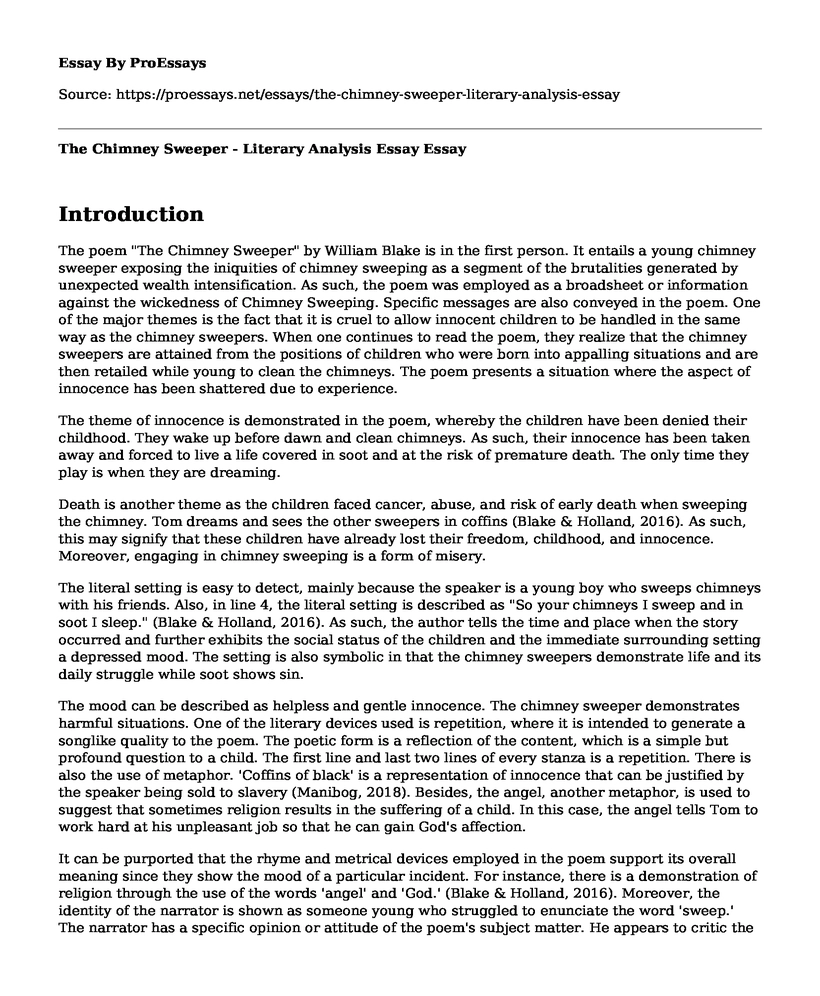Introduction
The poem "The Chimney Sweeper" by William Blake is in the first person. It entails a young chimney sweeper exposing the iniquities of chimney sweeping as a segment of the brutalities generated by unexpected wealth intensification. As such, the poem was employed as a broadsheet or information against the wickedness of Chimney Sweeping. Specific messages are also conveyed in the poem. One of the major themes is the fact that it is cruel to allow innocent children to be handled in the same way as the chimney sweepers. When one continues to read the poem, they realize that the chimney sweepers are attained from the positions of children who were born into appalling situations and are then retailed while young to clean the chimneys. The poem presents a situation where the aspect of innocence has been shattered due to experience.
The theme of innocence is demonstrated in the poem, whereby the children have been denied their childhood. They wake up before dawn and clean chimneys. As such, their innocence has been taken away and forced to live a life covered in soot and at the risk of premature death. The only time they play is when they are dreaming.
Death is another theme as the children faced cancer, abuse, and risk of early death when sweeping the chimney. Tom dreams and sees the other sweepers in coffins (Blake & Holland, 2016). As such, this may signify that these children have already lost their freedom, childhood, and innocence. Moreover, engaging in chimney sweeping is a form of misery.
The literal setting is easy to detect, mainly because the speaker is a young boy who sweeps chimneys with his friends. Also, in line 4, the literal setting is described as "So your chimneys I sweep and in soot I sleep." (Blake & Holland, 2016). As such, the author tells the time and place when the story occurred and further exhibits the social status of the children and the immediate surrounding setting a depressed mood. The setting is also symbolic in that the chimney sweepers demonstrate life and its daily struggle while soot shows sin.
The mood can be described as helpless and gentle innocence. The chimney sweeper demonstrates harmful situations. One of the literary devices used is repetition, where it is intended to generate a songlike quality to the poem. The poetic form is a reflection of the content, which is a simple but profound question to a child. The first line and last two lines of every stanza is a repetition. There is also the use of metaphor. 'Coffins of black' is a representation of innocence that can be justified by the speaker being sold to slavery (Manibog, 2018). Besides, the angel, another metaphor, is used to suggest that sometimes religion results in the suffering of a child. In this case, the angel tells Tom to work hard at his unpleasant job so that he can gain God's affection.
It can be purported that the rhyme and metrical devices employed in the poem support its overall meaning since they show the mood of a particular incident. For instance, there is a demonstration of religion through the use of the words 'angel' and 'God.' (Blake & Holland, 2016). Moreover, the identity of the narrator is shown as someone young who struggled to enunciate the word 'sweep.' The narrator has a specific opinion or attitude of the poem's subject matter. He appears to critic the material settings and organizations that publicize them as being caring, yet they have neglected these children working as chimney sweepers (Manibog, 2018). A society ought to be considerate about children who have been put in such severe living conditions, but it seems to have ignored their state. Parents, according to the attitude demonstrated by the narrator, should also be blamed as it appears they have neglected their children and failed to take full responsibility. The children should be playing or studying.
An analysis of "The Chimney Sweeper" has been conducted, and it has been shown that the innocence of young children has been destroyed due to experience. The experience, in this case, is from working as chimney sweepers. Also, the experience of these children is quite sad due to the work they do and the harsh working conditions as well.
References
Blake, W., & Holland, J. B. (2016). THE CHIMNEY SWEEP. The Complete Poetry and Prose of William Blake. Retrieved from https://literaryballadarchive.com/PDF/Blake1_Chimney_Inn_f.pdf
Manibog, L. J. (2018). New Perspectives on Paul and Marx: William Blake's<"> The Chimney Sweeper<"> in<<> i> Songs of Innocence and Experience<<>/i. Retrieved from https://scholarsarchive.byu.edu/cgi/viewcontent.cgi?article=8337&context=etd
Cite this page
The Chimney Sweeper - Literary Analysis Essay. (2023, Mar 29). Retrieved from https://proessays.net/essays/the-chimney-sweeper-literary-analysis-essay
If you are the original author of this essay and no longer wish to have it published on the ProEssays website, please click below to request its removal:
- Hamlet's Relationship With Gertrude
- Baldwin's Personalization in The Fire Next Time Essay Example
- Critical Essay on Literary Tools in The Tragedy of Hamlet
- The Tone and Style of Kate Chopin's Story of an Hour
- Susan Glaspell's Play "Trifles": Death of John Wright Essay
- "Heart of Darkness" by Joseph Conrad - Literary Analysis Essay
- Macbeth & Lady Macbeth: Contrasting Degrees of Evilness







